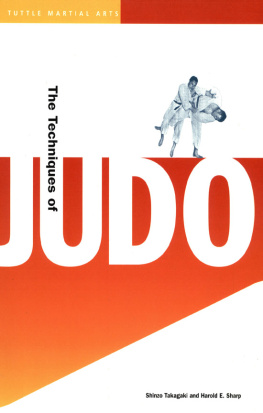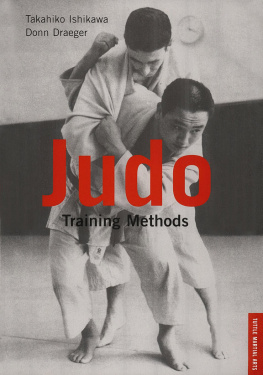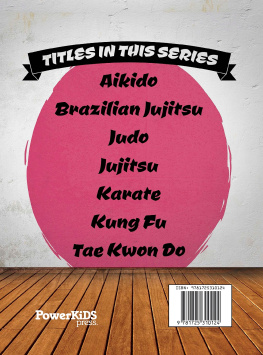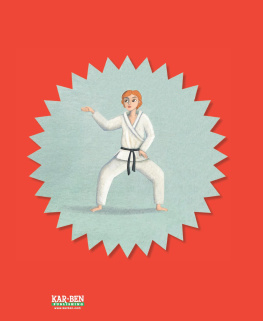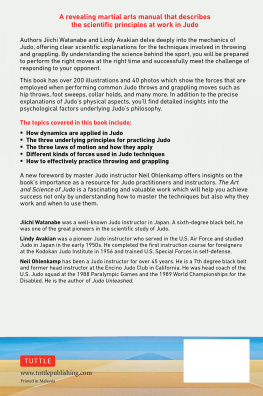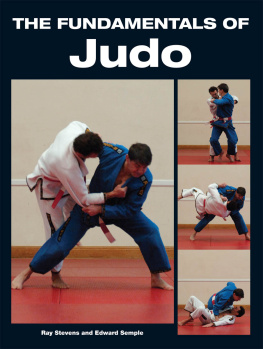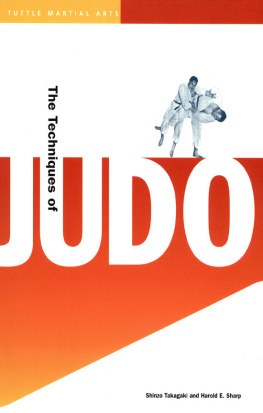 |
PART I
introduction |
CHAPTER 1
outline of judo |
J udo is both an art and a sport, a means of defense, and equally, a means of offense. Like jujitsu, its forerunner, judo is a method of turning an opponent's strength against himself, thus defeating him in the most efficient manner. Jujitsu was practiced seriously for many years in olden days as a means of killing or seriously injuring one's opponent, but with the advent of modern warfare the need for hand-to-hand combat diminished, until the sport almost died out.
In 1882 Mr. Jigoro Kano, a student of jujitsu, founded the Kodokan Judo Institute in Tokyo. There he formulated a new system of bare-handed fighting which he named "judo." Judo means "the gentle way,"and utilizes the very best of the jujitsu techniques, eliminating the harmful ones, and modifying others so that they can be practiced safely.
Judo is beneficial to both young and old, and age is no disqualification for becoming skillful. It exercises a benign effect on all the faculties of the student; and in emergencies can be used for self-defense,which of course constitutes one of the chief reasons why judo is so popular with police forces and the like.
THE OBJECTIVES
In a narrow sense judo can be defined as the study of the maximum use of the body and mind for the purposes of attack and defense. In a wider sense the principles of judo can be applied to all affairs of life. The ultimate objective of judo is the perfection of one's self by the systematic training of the mind and body through exercise so that each works in harmony with the other. Only such a person can be a valuable asset to his society.
It has been said that all games originated from some form of actual combat which, over the years, changed into sports. Judo today maintains the martial aspect of those early games. Its objectives are as follows:
1. Development of the body
2. Skill in contest
3. Mental and moral development
These objectives cannot be considered separately, but only in close conjunction with each other. In gymnastics one simply improves the muscles by mechanical movements of the limbs, and it is quite natural that there exists neither much interest nor much benefit in it. Judo is entirely different from gymnastics in that it is intended for the harmonious development of the body by bringing all groups of muscles into play, and in that it uses the mental abilities to supplement and advance one's skill in the sport.
The judo player must always keep in mind the eventual outcome of the contest ; his mind and body must work as one, always alert to the demands of the moment, his body able to move flexibly and with agility. Such automatic command of one's movement prepares the player to meet and avoid any threat. Although the proper use of the body is important, one's mental attitude is equally important for self-control and for grasping the opportunity of the moment, enabling you to defeat your opponent under adverse conditions.
The cultivation of the mind and morals naturally follows the close observance of true sportsmanship. Life is, as it were, a continuous struggle for existence, and only by applying the theory of games in personal affairs can one secure the knowledge necessary for success.
To sum up: first we must develop the body; second, we must defeat the opponent; and finally we must cultivate our morals. These are the true objectives of judo. If a student is wrong in thought or conduct he cannot be said to have mastered judo no matter how developed in body or techniques he may be.
THE TECHNIQUES
There are many different techniques in judo, but, as it is an entirely individual skill, the methods of application differ considerably among different teachers. The techniques ex-pounded in this book are based on the more than forty years of experience of Mr. Takagaki. The following outline indicates briefly the various methods involved.
1. Tacni-waza (also known as nage-waza) :standing and throwing techniques.
2. Ne-waza (also known as katame-waza) : lying and grappling techniques.
3. Atemi-waza: striking techniques.
Tachi-waza is a method of throwing the opponent by quick and harmonious action of the body. It requires long training for good form and timing. Since there is little time to ponder
during a match, one's actions must be as automatic as a reflex. Throwing techniques may be classified as follows:
1. Te-waza: hand throws
2. Koshi-waza: hip throws
3. Ashi-waza: foot and leg throws
4. Sutemi-waza (techniques of throwing the opponent by throwing yourself on the mat)
a. Ma-sutemi-waza: back throws
b. Yoho-sutemi-Waza : side throws
Although the above classifications specify the use of a particular part of the body, all techniques require body action.
Ne-waza includes the following methods for fighting the opponent on the ground.
1. Osaekomi-waza: holding techniques
2. Shime-waza: strangling techniques
3. Kansetsu-waza: armlock techniques
Atemi-waza includes the methods of striking the opponent's body. Only the theory of this technique is studied, as it is never practiced today. (See page 20.)
THE CONTESTS
In a judo contest, only one point is needed to defeat the opponent. Because there is no second chance, both contestants are under great strain. The contest lasts only a few seconds, though it may seem like hours to the contestants. Proficiency in a contest is one of the ultimate tests of a judo-man's ability. Points may be awarded on the following basis:
1. A clean throw that lands the opponent on his back.
2. Holding the opponent for thirty seconds from the moment the referee calls time on the hold. If the opponent coils his legs around one of your legs, time is not counted. You must have complete control of his body.
3. Making the opponent surrender by applying a strangling hold or by twisting the elbow joint. No part of the opponent's body may be twisted other than the elbow.
In the event that neither opponent obtains a point within the allotted time, then the referee may arbitrarily award the decision. A contestant may lose by default or by unsports-man-like behavior. Although such occurrences are rare among judo-men, the rules provide for such contingencies.
Grading in judo is based on one's ability. This ability is usually measured by proficiency in contests ; but it is also judged by special examinations and by the student's general conduct as well as knowledge of judo. Differences in grading are shown by differences in the color of the belts worn with the judo suit. Beginners wear brown or white belts. Within the beginner's group there are five classes, from 5th to 1st class. The top three classes wear a brown belt. After a student is graded he wears a black belt. The grades range from 1st grade to 10th grade. Special types of belts are worn by high-grade practitioners, like the red-and-white belt from 6th through 8th grades and the red belt for 9th and 10th grades.
GRADE | COLOR OF BELT |
ju-dan | 10th.grade | red or black |
kyu-dan | |

